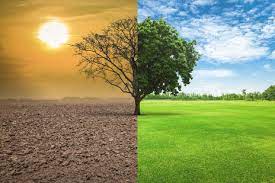Climatic classification is the categorization of climates based on various criteria such as temperature, precipitation, and other atmospheric conditions. The classification system provides a framework for understanding and analyzing the different climate types found across the globe. This article will provide an overview of climatic classification, including the types of climate and the factors that influence them.

Table of Contents
What is Climate?
The climate is the long-term average of weather conditions in a particular region. The climate is determined by a variety of factors, including latitude, altitude, topography, and proximity to large bodies of water. Climate classification systems attempt to group regions with similar climates based on these factors.
Basis of Climatic Classification
Empirical and genetic classifications are two different approaches to classification that are used in the classification of climate. While both methods aim to group similar items or organisms together, they differ in the way they establish these groups and the underlying principles they rely on.
Empirical climate classification is based on observed climate patterns, such as temperature, precipitation, and atmospheric conditions, without considering the underlying mechanisms that give rise to them. Empirical climate classifications include the widely used Koppen-Geiger climate classification system, which categorizes climates based on temperature and precipitation patterns, and the Thornthwaite climate classification system, which takes into account the water balance of an area.
Genetic climate classification, on the other hand, is based on the underlying mechanisms that determine climate patterns. This includes factors such as the Earth’s orbit, atmospheric circulation, and the distribution of land masses and oceans. Genetic climate classifications aim to reflect the physical processes that give rise to the observed climate patterns and may be used to make predictions about how climates may change in the future.
One example of genetic climate classification is the paleoclimate classification system, which categorizes climates based on past geological and environmental conditions. This classification takes into account factors such as changes in the Earth’s orbit and axis, volcanic activity, and the distribution of land masses over geological time.
Another example of genetic climate classification is the atmospheric circulation classification system, which categorizes climates based on the patterns of atmospheric circulation and pressure systems. This classification takes into account the movement of air masses, the location of high and low-pressure systems, and the distribution of precipitation.
Climatic Classification by Koepen
The most widely used climate classification system is the Koppen climate classification system. It was developed by German climatologist Wladimir Köppen in the early 20th century and has been revised several times since then. The Koppen system divides climates into five major groups based on temperature and precipitation patterns. These groups are further subdivided into specific climate types.
The five major groups in the Koppen classification system are:
- Tropical Climates: These are the warmest climates found on Earth and are characterized by high temperatures and high humidity. They are found in the equatorial regions and are further divided into three types: Af, Am, and Aw.
- Dry Climates: These climates are characterized by low precipitation levels and are found in arid and semi-arid regions. They are further divided into two types: B and H.
- Temperate Climates: These climates are characterized by moderate temperatures and rainfall and are found in the middle latitudes. They are further divided into four types: Cfa, Cfb, Cfc, and Cwa.
- Continental Climates: These climates are found in regions that experience large temperature variations throughout the year. They are further divided into three types: Dfa, Dfb, and Dfc.
- Polar Climates: These are the coldest climates found on Earth and are characterized by very low temperatures and low precipitation levels. They are further divided into two types: ET and EF.
In addition to the Koppen system, there are other classification systems that are used to categorize climates. These include the Thornthwaite system, the Trewartha system, and the Bergeron system. Each of these systems uses different criteria to classify climates and may be more appropriate for specific regions or purposes.
In conclusion, climatic classification provides a useful framework for understanding and analyzing the different climate types found across the globe. The Köppen climate classification system is the most widely used system and divides climates into five major groups based on temperature and precipitation patterns. Other classification systems exist and may be more appropriate for specific regions or purposes. Understanding climatic classification is important for a variety of applications, including agriculture, urban planning, and climate change research.
Important Links